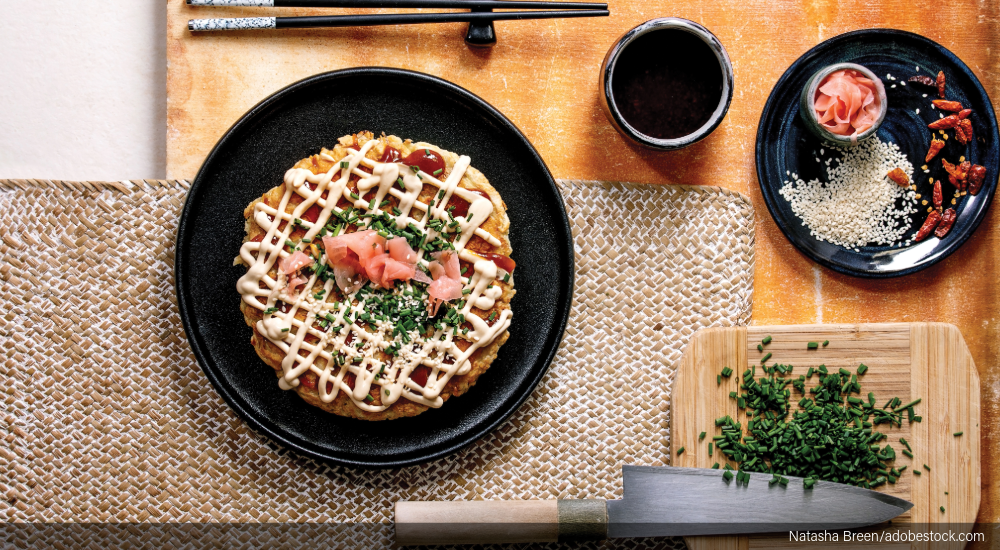Exploring the exciting world of international specialty pizzas | Global Meltdown
It was 10:30 a.m. at the Athens Farmers Market when I gave a young couple a few small samples of the Barbari e Za’atar I had baked the previous night. As I handed them the samples, I knew I would make a sale.
This three-foot-long bread looked like the traditional Pizza alla Pala – a Roman, stretched-dough pizza – but it was thinner and topped with Za’atar mixed with extra virgin olive oil. The Jordanian Za’atar was salty, savory, nutty and herbaceous, with a citrus finish that is irresistible on toasted wheat.
“So, is this a pizza?” the man asked, repeating a question I hear every weekend.
“Sort of.” I stayed intentionally muted as I saw their eyes roll in delight as they chewed. It was time for my closing sales pitch, “I baked 30 of those last night. That’s one of the last few. It’s perfect with goat cheese and salad.”
Boom. They gave me the money, a thank you and walked away.
Was this Barbari e Za’atar in any way a pizza? Yes and no. The foggy definitions of what constitutes a pizza these days are in the eye of the beholder. A lot of this argument depends upon words, history and geography – but, most importantly, the expansiveness of your pizza horizon.
Whether they’re called pizza, pita, pide, lehmejun, lahmacun, khachapuri, flammkuchen, fugazza or tlayuda, these multicultural dishes all involve baked crusts with toppings. I’ve researched and tried most of them (to the delight of my customers), which has broadened my pizza horizons and given my menu-mix an international twist. Let’s face it, a lot of pizzas are not labeled as such – even in Italy. Let’s start with a few pizzas by another name.
What a few pizzas by another name around the World? Yeast on Earth
Focaccia di Recco:
This very thin-crusted, pan-baked, “stuffed pizza” from Liguria is a beauty to behold. The two thin crusts are baked to crisp, drizzled with olive oil and salt and encase gooey cheeses such as Crescenza (also referred to as Stracchino) or a lighter, tangier Prescinsêua cheese.
Sfincione:
This true Sicilian pizza from Palermo mimics its original Latin name spongia, or sponge. It usually is baked in a long, rectangular pan, which gives the pie a crispy bottom. The crust is spread with olive oil, tomato passata, onions, oregano and anchovy. Aged caciocavallo or Pecorino Romano cheese is sprinkled on top, followed by breadcrumbs.
Pissaladeira:
This pizza also is called Sardenaira and is popular in the Western Riviera of Italy. It is more like its French namesake, Pissaladière, than anything in Naples. Like the Sfincione, Pissaladeria relies upon the flavor profile of local ingredients native to its region. It has a thick, pan-baked crust topped with caramelized onions, anchovies and taggiasca (Cailletier) olives – as opposed to the Niçoise olives used in the French version.
What are unique pizzas and flatbreads from our diverse world? Local Kneads
Here are some unique pizzas and flatbreads from our diverse world. Many remain obscure outside their regions, which can give you a template for new flavor profiles in your pizzeria.
Socca:
This French version takes it cue from the old Roman Cecina; using dried and ground garbanzo beans, first baked when flour was too expensive. This crust is gluten-free, high in protein and usually baked in an oiled pan or skillet and topped like a traditional pizza. Variations are abundant: In Genoa, it is called Farinata; Argentina and Uruguay have their own version, Fainá.
Pide:
This Turkish pizza is a favorite of my customers, who love the long-boat-shaped Kiymali Pide, meaning “minced meat.” I make this with lamb and beef seasoned with Arabic seven-spice, roasted onion, peppers, parsley and pomegranate molasses, Jibneh Arabieh and Palestinian Nabulsi cheese with fresh pomegranate and mint (see recipe).
Get the Kiymali Pide Pizza Recipe.
Okonomiyaki:
This Japanese pizza pancake translates to “grilled as you like it,” and was first developed in 1930s Osaka. It consists of wheat flour mixed with eggs, shredded cabbage and a multitude of other ingredients such as pork belly, shrimp, squid, scallion and noodles. It is then topped with bonito flakes and okonomiyaki sauce, which is made with Worcestershire, oyster sauce, honey, sugar, soy sauce and sometimes vinegar added for depth. I loved eating this when I lived in Japan.
Langos:
This Hungarian pizza comes from the word “lang,” meaning flame. In the past century, it only was baked once per week due to the cost of heating the oven. Some bakers add milk, sour cream, yogurt or even mashed potatoes to the dough. It is eaten warm with sour cream and grated cheese or Liptauer, a spicy cheese spread. Toppings such as ham, sausage, mushrooms, quark cheese, eggplant and cabbage are used – or the crust simply can be brushed with garlic.
Banrakhash:
This pie comes from the Kurdish and Armenian regions that have seen tough times and uses both old and dried bread and hard cheeses. These are baked in a pan together with melted butter, cream, yogurt and herbs with nigella seeds and/or tarragon.
Coca:
This Spanish pizza is popular, especially in the Balearic Islands. The base can be blended with or without egg or yeast and can be thick or thin, sweet or savory and topped with everything under the sun. The Coca D’Espinacs are made with spinach, pine nuts, raisons and olive oil – and the Coca Amb Trempó is made with summer vegetables. Fish, anchovies, tomatoes, eggplant and olives are popular as well as some cheese cocas with manchego, Mahon, pata de mulo and Valdeón.
JOHN GUTEKANST owns Avalanche Pizza in Athens, Ohio.



